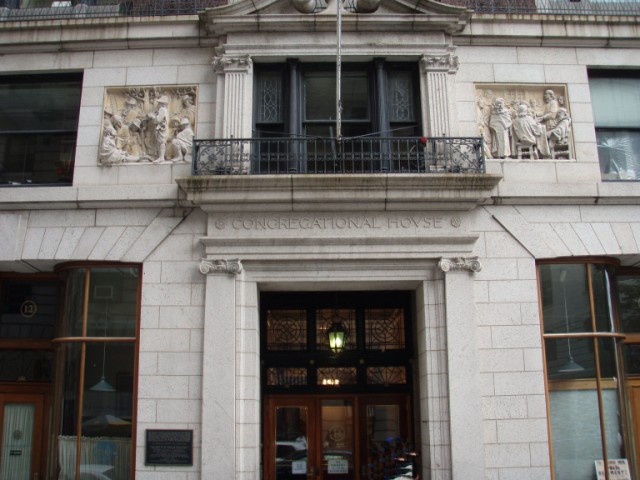
Although the Congregational Library is a private institution, most of its vast resources are open to the public, and there are many resources available online. Newer books are available for circulation, while copying privileges are extended for older material. It is a particularly rich resource for genealogical research.
The historic building at 14 Beacon Street features a set of unique marble bas-relief sculptures representing four of the foundational principles of Congregationalism: Law, Religion, Education, and Philanthropy. Built in 1898, the Congregational House is a contributing building the the Beacon Hill National Historic District.
From the Congregational Library web site.
Formed in 1853 with the gift of 56 books from its owners' personal collections, the Congregational Library now holds 225,000 items documenting the history of one of the nation's oldest and most influential religious traditions.
The Congregational Library and Archives are administered by the American Congregational Association, a non-profit organization founded May 25, 1853. The 1853 ACA charter stated that the organization was incorporated "for the purpose of establishing and perpetuating a library of religious history and literature of New England, and for the erection of a suitable building for the accommodation of the same, and for the use of charitable societies." It was felt that the latter should be done or the original Puritan literature would be lost.
After 1957 many Congregational churches joined the United Church of Christ and the Library was designated as the records repository for the General Council of the Congregational Christian Churches, the central denominational board of the Congregational church. In addition to these records, numerous associations, organizations and movements from the Congregational tradition have given their records to Congregational Library archives.
From the
Boston Art Commission
The Congregational House was built in 1898 to house various religious and secular organizations associated with the Congregational faith, a Protestant denomination that flourished in the New England colonies. Among its original tenants were a bookstore, a printing press, and educational and missionary associations.
Today, the building houses the Congregational Library and Archive. A wealth of historical and religious documents can be found in its collections, including a ledger recording Benjamin Franklin’s baptism in 1706.
On the House’s exterior, four marble carvings illustrate the core values of the building’s first occupants. At the far right, a scene representing Law shows the Church members signing the Covenant. The next scene, Faith, depicts Church members holding services outdoors. This portrayal emphasizes the autonomous nature of Congregational Churches, which function independently of higher governing organizations.
The third relief represents Education and portrays the founding of Harvard College by the General Court of the Massachusetts Bay Colony. Finally, the last relief illustrates Philanthropy. Here,missionary John Eliot is shown preaching to a group of Native Americans. The reliefs were carved by Spanish artist Domingo Mora, who also worked on the exterior of the Boston Public Library.
There seems to be some dispute, however, about the exact execution of these four relief sculptures. An interesting article from indicates that Mora abandoned the project which was finished by an unnamed Swiss artist.
From
The Boston Book
published in 1899. [emphasis added]
The Congregational House
For a quarter of a century the headquarters of Congregationalism in Boston were at the corner of Beacon and Somerset Streets. In 1871 the American Congregational Association purchased the Somerset Club House and an adjoining estate, reconstructing them so that they were suitable for occupancy by the various Congregational organizations, which up to that time had been domiciled in several buildings in different streets. The first Congregational House was dedicated February 12, 1873.
For many years this building seemed spacious and was regarded as ample for its purposes. But Congregationalism grew with the city and the country, and when the first International Council in 1891 voted that the second council should be held in the United States -- of course looking to Boston as the place -- the question of having a new Congregational House was already being seriously considered. The approach of the meeting increased the interest in providing a new building and probably hastened its erection.
The land on which the Congregational House now stands, with the other lots as far as Park Street, was the property of the town of Boston, and was sold by it to Thomas Amory about one hundred years ago, A double house was built on this lot by a Mr. Payne, a representative of one of Boston's oldest families, and that house came into the possession of the Whitmore family about twenty-five years ago; thence in 1896 it became the property of the American Congregational Association. It is now No. 14 Beacon Street.
The architects of the new building were Messrs. Rutan, Shepley, and Coolidge, and the cornerstone was laid with appropriate ceremonies November 27, 1897. The late Dr. C. A. Berry, of Wolverhampton, England, made one of the addresses on that occasion. The edifice was so far completed by August 1, 1898, that some rooms were occupied, and before the end of that month nearly all the occupants of the old building had moved into the new one.
The relief sculptures on the facade of the second story have an interesting history. They were begun, under the direction of the building committee and of Rev. E. G. Porter, who conceived and suggested the designs, by a young Spaniard; but on the outbreak of war between his country and ours, he abandoned his work, and it was completed by a Swiss. The four subject represented by historical scenes in the founding of New England are Law, Religion, Education, and Philanthropy. The tablets are seen to the best advantage in the afternoon light from the opposite side of the street or near Bowdin Street. Photographs of them have been reproduced, in convenient form, with descriptions, by The Congregationalist.
There are two stories below the entrance on Beacon Street, and in the lowest story is the well-lighted and attractive Pilgrim Hall, seating about three hundred persons. The remaining rooms on this and the next floor above are for storage and packing and general purposes. The entrance floor, on the right, is occupied by the bookstore of the Congregational Sunday-School and Publishing Society.
The library, with its spacious reading room, has the place of honor on the second floor; and connected with it is the room containing a very interesting collection of Bibles, manuscripts, and other treasures gathered by Mrs. S. B. Pratt. The third, fourth, and fifth floors are mostly occupied as offices by various parties who rent these rooms from the Association. On the sixth and seventh floors are rooms of the benevolent societies and organizations administering the work of the denomination. The eighth floor is occupied by The Congregationalist, by Deacon Thomas Todd and his company of compositors, and by the editorial forces of the Sunday-School and Publishing Society.
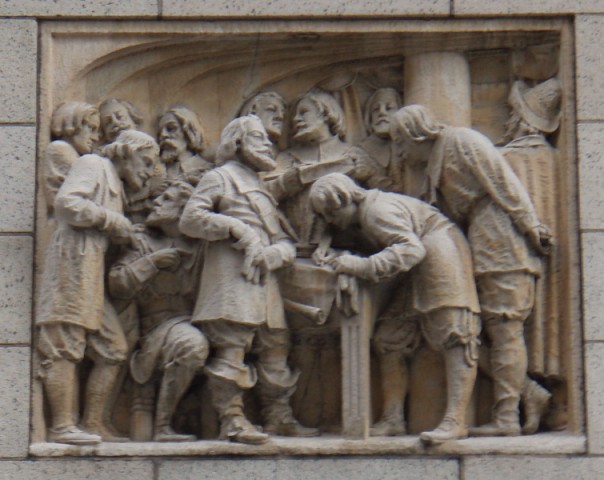
Rule Under Law by the Consent of the Governed
The Signing of the Mayflower Compact, 1620
Two of the scenes were taken from the Old Colony and two from that of the Bay''
The first controlling sentiment which was exhibited by our forefathers even before they landed, was the necessity of a recognized government to guard their fondly-cherished liberties. They made admirable provision for this in the solemn compact which was drawn up on board the Mayflower in Cape Cod harbor and promptly signed by the forty-one men of the little company. Here the scene was a perfect embodiment of the idea portrayed, viz. the majesty of law.
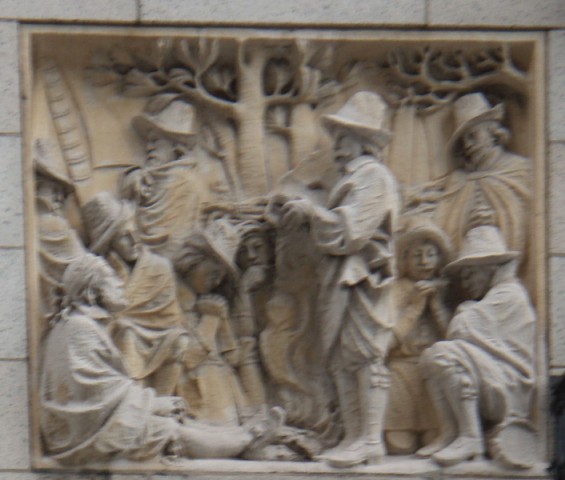
Worship According to Conscience
The First Sabbath on Clark's Island, 1620
Next came the most characteristic trait of the fathers -- the expr. of their religious faith. Several scenes might have been chosen for this. One preferred was the remarkable observance of the Sabbath by the exp. party on Clark's Island the day before they set foot on Plymouth Rock.
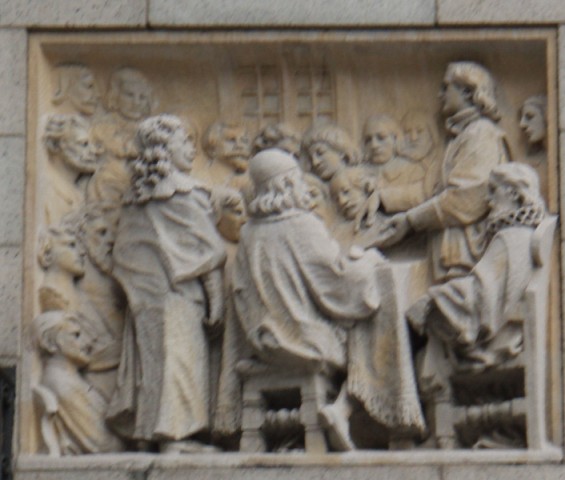
Education for Leadership
Act of the General Court of Massachusetts
Appropriating Funds for a "Schoole or Colledge"
Harvard, 1636
The third subject -- education -- offered itself at once as the ever-present handmaid of religion in New England, and the appropriation of the General Court, Oct. 18, 1636, for 'a school or college,' was an event of such extraordinary interest in itself and in its consequences that it was selected without hesitation. Boston has this honor, as the courts which had met at Cambridge (Newe Towne) during a part of the previous year in Boston from May, 1630, till May, 1637, when they returned to Cambridge for a short time and were there when the committee of six magistrates and six ministers was appointed (Nov. 20,. 1637) 'to take order for a college at Newtown.' The name of Harvard was adopted the following year.
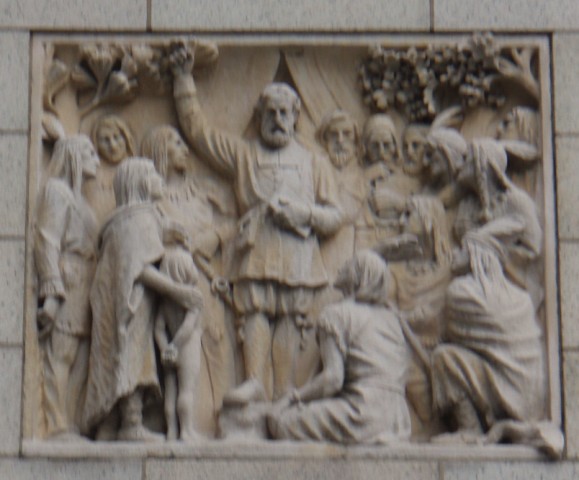
Community Witness
The Apostle Eliot Preaching Among the Indians, 1646
The fourth tablet is intended to set forth the beneficent fruits of the Congregational faith and practice; not in an exclusive, but in an historical sense, for which, indeed, the building itself exists, with the various denominational societies sheltered within its walls.
The evangelic spirit, drawn directly from the New Testament and encouraged by an enlightened mind and a consecrated heart, finds expression in missions of all kinds at home and abroad. The efforts of the apostle Eliot to establish 'praying villages' among his beloved Indians furnishes the theme for this, and he is represented as preaching to them at Waban's wigwam on the hlll at Nonanfum in 1642. No better example of true philanthropy could be found in the annals of an country, ancient or modern. -- Edward G. Porter in The Congregationalist
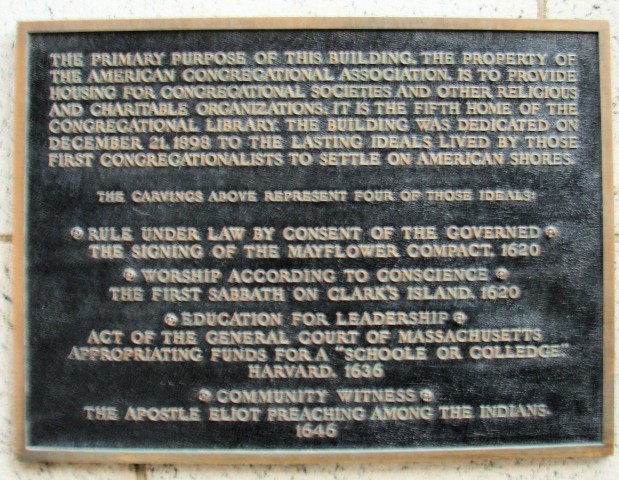
THE PRIMARY PURPOSE OF THIS BUILDING, THE PROPERTY OF
THE AMERICAN CONGREGATIONAL ASSOCIATION, IS TO PROVIDE
HOUSING FOR CONGREGATIONAL SOCIETIES AND OTHER RELIGIOUS
AND CHARITABLE ORGANIZATIONS. IT IS THE FIFTH HOME OF THE
CONGREGATIONAL LIBRARY. THE BUILDING WAS DEDICATED ON
DECEMBER 21, 1898 TO THE LASTING IDEALS LIVED BY THOSE
FIRST CONGREGATIONALISTS TO SETTLE ON AMERICAN SHORES.
THE CARVINGS ABOVE REPRESENT FOUR OF THOSE IDEALS
RULE UNDER LAW BY THE CONSENT OF THE GOVERNED
THE SIGNING OF THE MAYFLOWER COMPACT, 1620
WORSHIP ACCORDING TO CONSCIENCE
THE FIRST SABBATH ON CLARK'S ISLAND, 1620
EDUCATION FOR LEADERSHIP
ACT OF THE GENERAL COURT OF MASSACHUSETTS
APPROPRIATING FUNDS FOR A "SCHOOLE OR COLLEDGE"
HARVARD, 1636
COMMUNITY WITNESS
THE APOSTLE ELIOT PREACHING AMONG THE INDIANS
1646
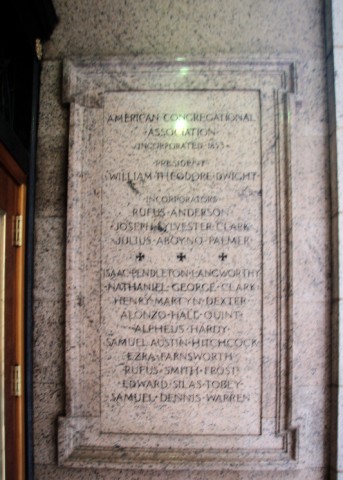 |
AMERICAN CONGREGATIONAL
ASSOCIATION
INCORPORATED 1853
PRESIDENT
WILLIAM THEODORE DWIGHT
INCORPORATORS
RUFUS ANDERSON
JOSEPH SYLVESTER CLARK
JULIUS ABOYNO PALMER
ISAAC PENDLETON LANGWORHTY
NATHANIEL GEORGE CLARK
HENRY MARTYN DEXTER
ALONZO HALL QUINT
ALPHEUS HARDY
SAMUEL AUSTIN HITCHCOCK
EZRA FARNSWORTH
RUFUS SMITH FROST
EDWARD SILAS TOBEY
SAMUEAL DENNIS WARREN
|
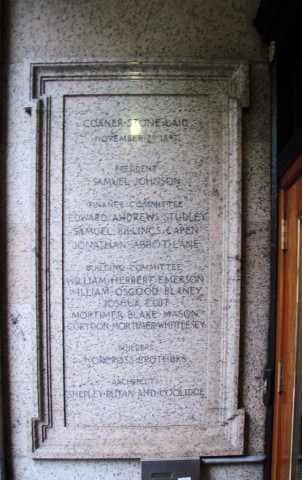 |
CORNER STONE LAID
NOVEMBER 27, 1897
PRESIDENT
SAMUEL JOHNSON
FINANCE COMMITTEE
EDWARD ANDREWS STUDLEY
SAMUEL BILLINGS CAPEN
JONATHAN ABBOT LANE
BUILDING COMMITTEE
WILLIAM HERBERT EMERSON
WILLIAM OSGOOD BLANEY
JOSHUA COIT
MORTIMER BLAKE MASON
CORYDON MORTIMER WHITTLESEY
BUILDERS
NORCROSS BROTHERS
ARCHITECT
SHEPLEY RUTAN AND COOLIDGE |